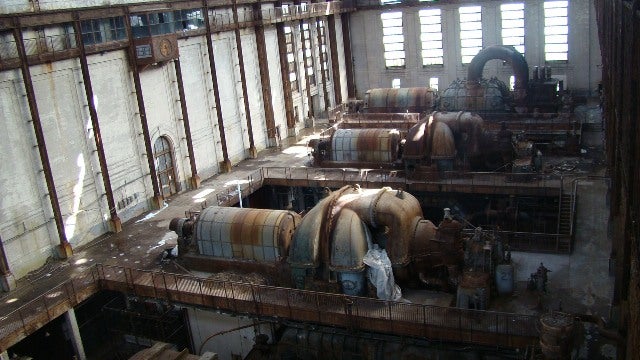Peeking at a powerful past

Richmond power station photos by Exelon spokesman Fred Maher
June 15
By John Davidson
For PlanPhilly
Of all the remnants of Philadelphia’s industrial past along the Delaware waterfront, the Port Richmond and Delaware power generation stations stand out as classical, imposing monuments to early 20th century industry.
Designed by John T. Windrim and W.C.L. Eglin, the Delaware station was completed in 1917 and the Port Richmond station in 1925. Together, these coal-fired power plants fueled the vibrant manufacturing industry of North Philadelphia with the most state-of-the-art machinery and engineering. At its peak, the Port Richmond station’s four huge steam turbines had a capacity of 600 megawatts.
But now these vaulted glass and steel buildings sit in ruins on the river’s edge. PECO still occasionally operates out of a section of the Delaware station during periods of peak power use, but the Port Richmond station is completed vacant. It closed as a full-time power plant in 1984 and since then its primary use has been as a set for big budget Hollywood films such as 12 Monkeys, Transformers 2, and most recently, The Last Airbender, which completed filming at the plant last month.
And no wonder: Hollywood can’t build sets like the Port Richmond station, no matter how big the production budget might be. The station’s massive boilers, turbine hall and electrical rooms have been re-imagined as futuristic psych wards, time machines, spaceships, and for several weeks last year during the filming of Transformers 2, as the Decepticons lair.
Ironically, the former power station no longer has power, so when film crews come to town they must set up huge generators in the parking lot. “When they come in here to film the place get’s lit up like a shopping mall,” says Exelon Asset Manager Mark Wilson.
Part of Wilson’s job is to keep the building stable and secure–not just for film crews but also because Exelon isn’t certain about the derelict facility’s fate. Despite rumors last year that Exelon was planning to demolish the Delaware station, which sits directly north of Penn Treaty Park, spokesman Fred Maher says the company’s current position on both the Delaware and Port Richmond stations is status quo.
“We’re holding it until we figure out what we’re going to do with it,” Maher says. “There’s been no decisions made on selling it, demolishing it or anything right now.”
Any demolition at the sites, like the removal last year of the northern façade of the 1954 addition at the Delaware station, has been motivated by a concern for safety, says Maher. Although the company reportedly holds demolition permits for the Port Richmond station, it has not indicated any intention to follow through.
In the meantime, Wilson is fighting a constant battle against rogue metal scrappers, who occasionally still manage to find a way into the huge facility and remove steel and copper. In recent years, high scrap metal prices have emboldened scrappers and forced Wilson and his crew to shore up the crumbling power station by erecting steel plates over unused entryways. Exelon also maintains a high security fence and gate system for the facility, which is adjoined by a modern office building in regular use.
Part of the reason Exelon wants to keep people out, explains Wilson, is because the building is not a safe place to wander unsupervised. On a recent walk-through, Wilson pointed out numerous areas throughout the facility that, because of “25 years of decay” are structurally unsound. Without power, the interior of the station–a dizzying maze of industrial machinery and catwalks–is in pitch darkness at night.
But despite its current state of decay, the station’s combination of classic, Romanesque architecture and modern industrial machinery make it, along with its sister station a few miles south, altogether unique features of the Delaware riverfront. Some have suggested the stations be renovated and turned into museums on the model of the Tate Museum in London.
Hilary Regan, a Northern Liberties resident, has put forth the Calder Museum proposal–a plan to convert the Delaware station into a massive museum. Regan’s proposal makes reference to the $65-million conversion of the historic Chester generating station into office and event space in 2002. Developers purchased the property from PECO for a mere $1 million.
Local interest in preserving the Port Richmond and Delaware station persists. The Port Richmond plant has been–albeit unsuccessfully–nominated for the historic properties register maintained by the city’s Historical Commission, but currently neither station enjoys any kind of protection.
If nothing is done with the stations, they will certainly continue to crumble. Sections of the Port Richmond station’s vaulted ceiling above turbine hall occasionally come down, and Wilson’s crew keeps a watchful eye and maintains a huge net around the most precarious sections. Portions of the ceiling in the main hall and elsewhere are open to the elements, and standing water under the turbines rises and falls with the tides.
Film productions have not helped to preserve the building, as directors require minor changes to the building’s physical features. During the filming of Transformers 2 last year, the crew received permission to perform a controlled explosion in the turbine hall, blowing up a small glass-and-metal structure. More recently, during filming for The Last Airbender, a lower section of one of the main turbines was painted black and red and fitted with rivets to give the appearance of a ship.
But in the context of such a massive space, these alterations are relatively minor, and Exelon, via Wilson, is careful that nothing vital to the building’s structural integrity and overall character is changed.
Contact the reporter at jddavidson9@gmail.com
WHYY is your source for fact-based, in-depth journalism and information. As a nonprofit organization, we rely on financial support from readers like you. Please give today.



